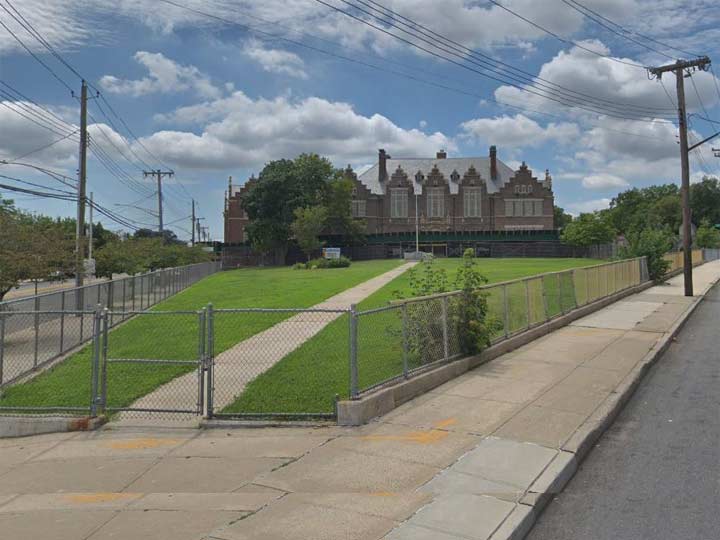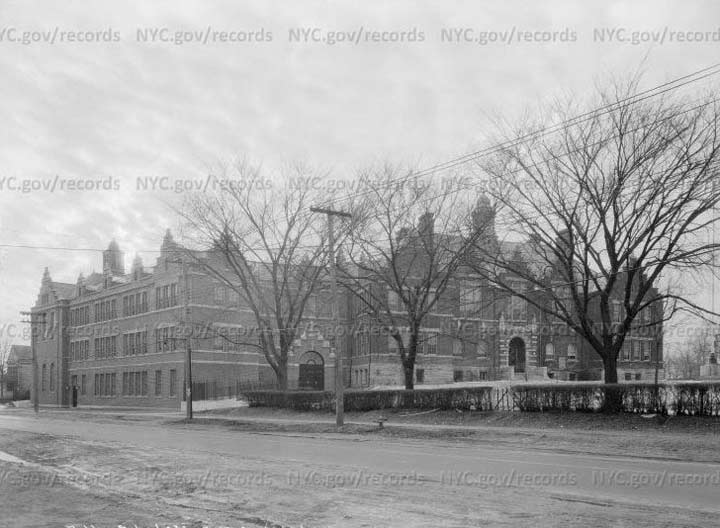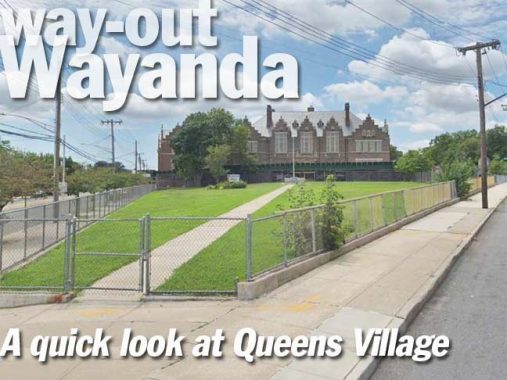By SERGEY KADINSKY
Forgotten NY correspondent
In the section of Queens Village to the south of the train tracks where Springfield Boulevard meets Hollis Avenue is a remarkable building: the John Harvard P. S. 34, built in 1897. Its Flemish Renaissance appearance is similar to that of Newtown High School in Elmhurst, both designed around the same time by prolific public school architect CBJ Snyder. While the latter is an official city landmark, the one here does not have the appreciation of the city’s cultural officials.

When the school was built much of the surrounding area was farmland sprinkled with residences dating to the colonial period. Known historically as Little Plains, the terrain here was wide open as the eastern edge of the larger Hempstead Plains, a post-glacial grassland that once covered 60,000 acres between Queens Village and the Suffolk County border. Its flatness made it an ideal place for farming, grazing, horse racing, and early aviation.

Following the completion of the railroad tunnel to Penn Station in 1910, suburban development in Queens Village rapidly picked up. With more students signing up, the school expanded with a wing facing Springfield Boulevard. But instead of grafting an Art Deco or Moderne design to the wing, the architects faithfully continued with Flemish Renaissance of the original building. Nothing looks uglier than having a modernist addition to a historicist building. Perhaps it is in a nod to its appearance that this school is co-named after the founder of the country’s most prestigious university. Snyder’s designs were meant to evoke higher learning to inspire public school students.
My own alma mater, PS 139 in Rego Park has a Snyder-designed core with a non-matching 1960 gym/auditorium wing. Fortunately in the late 1990s, the kindergarten wing was given matching red bricks and cornice line of the original design.
Behind P. S. 34 is the 2.5-acre Wayanda Park, which features a lawn, playground, handball and volleyball courts. The park’s lawn has a morbid past as the Town of Jamaica Potter’s Field, authorized for such use in 1844. In contrast to the Olde Towne of Flushing’s Burial Ground, this one never received its proper respect. An 1872 report notes that the paupers and criminals buried here do not have tombstones. With no visitors to pray for the deceased, in 1908, local residents petitioned the city to designate the property as a park. It opened in 1912 as Wayanda Park, taking its name from the Native term “place of happy hearts.” I am not sure who found this translation proper as the Iroquian Wyandot nation is thought to mean “dwellers on a peninsula.” There’s also Wyandanch on Long Island, the translation of this term apparently lost to history.
In 2002, human remains were found under the park and in the following year a Cultural Resource Survey was conducted in the park in search of further remains. In contrast to the Flushing burial ground, which received a historically-themed reconstruction between 2004 and 2009, Wayanda’s appearance has not changed since 1970 when an annex of PS 34 was built on the edge of the park. This single-story structure has none of the school’s Flemish flair, resembling a trailer in its appearance.
Across Hollis Avenue facing the park is the Roman Catholic Church of Saints Joachim and Anne. Founded in 1896, its membership today is largely comprised of Haitian immigrants. I am fascinated by the church’s stained glass windows, which resemble those on the Great Hall at the New York Hall of Science. The namesake saints are the grandparents of Jesus, born through their daughter Mary. As these two saints predate Jesus, I’ve wondered why Christianity doesn’t refer to earlier biblical figures as “St. Abraham,” or “St. Moses?” Why isn’t their defining prophet referred to as “St. Jesus?” I’m certainly not an expert in Christian nomenclature, comments are welcome to explain it to me.
Being so close to the city line, I took a quick jog to the Queens-Nassau border on Hempstead Avenue, also known as NYS Route 24. At Belmont Park, the border is very clear. There’s a Nassau County sign, change in paving, and lamppost design. But the real gem here is the underpass below Hempstead Avenue that straddles the borderline.
Prior to 1958, this tunnel was used by the Belmont Park branch of the Long Island Railroad. Trains terminated on the southern side of the road, close to the village of Elmont. In 1957 the station was relocated to the north side of the road, closer to the grandstand.
While the horse racing track is entirely in Nassau County, the station is within the border of Queens. For decades local leaders have been pushing to make Belmont Park a commuter station, but the railroad and the racetrack continue to argue that there is not enough capacity on the Main Line to accommodate a new branch. For now, residents of Elmont must take their cars or a bus to Queens Village to catch the train.
[When the new hockey stadium for the Islanders is built adjacent to Belmont Park, a new connection to the main line will have to be built. — Ed.]
The development of Hollis and Queens Village was in piecemeal fashion, with subdivisions surrounded by farmland, and eventually they expanded toward each other. Many of these early developments had sidewalk gates as seen here on 115th Avenue.
The piecemeal development of former farm properties also resulted in the laying of streets that did not line up with each other, resulting in repeated numbering and preservation of names in some cases, as in Robard Lane that borders on Wayanda Park. As seen above in the 1918 Belcher-Hyde atlas.
Another such development is Bellaire Park, which has a more detailed history. In 1900, a property south of the tracks opened to the public as Interstate Park, operated as a casino and shooting range operated by the National Trapshooting Association. At its annual Grand American tournament, flying birds were released from their cages and shot by trained marksmen. Even in those days the concept of releasing a bird from it cage and killing it as it flies for freedom was highly unpopular. The state banned this sport two years later and the shooting range went out of business. Interstate Park was sold for residential development in 1906 and renamed Bellaire.
As the 1918 Belcher-Hyde map shows, Bellaire was two blocks in width, with a boulevard running down its middle. In compliance with the borough-wide numbering grid, Bellaire Boulevard was renamed after 1911 as 211th Street.
The green medians on this road are maned as a linear park named Mall 211. Note that in Queens Village there was a four block-long Queens Boulevard. To avoid confusion with the much lengthier Queens Boulevard in western Queens, this was numbered as 99th Avenue.
At the underpass of 211th Street and the Long Island Railroad we see metal protrusions on the trestle indicating remnants of a platform. Prior to 1972 this was the Bellaire station on the Hempstead Branch. It closed due to lack of ridership and proximity to the Queens Village station. On this block the Ar-Rahman Mosque piqued my attention. Its yellow brick design is reminiscent of the architecture in Israel and the Palestinian territories, where Jerusalem stone is the preferred building material. I couldn’t take the train home from here, but this is where I’m ending my slice of Queens Village.
If you wish to see more of this neighborhood, have a look at Kevin’s essays. He has an 1852 map that shows the intersection at P. S. 34 as having a long history. In 2005, he took the train to Queens Village. Then in 2011, he walked on Jamaica Avenue from downtown Jamaica to Queens Village.
Our biggest source of pride in Queens Village is the .074-acre Litchhult Square, a tiny park whose namesake was all but forgotten. As a result of our page on this tiny park, two Litchhult descendants emerged to tell the family’s connection to this park and the namesake turned out to be Lt. Andrew Slover Litchhult (1895-1936).
Sergey Kadinsky is the author of Hidden Waters of New York City: A History and Guide to 101 Forgotten Lakes, Ponds, Creeks, and Streams in the Five Boroughs (2016, Countryman Press) and the webmaster of Hidden Waters Blog.
Please help contribute to a new Forgotten NY website
Check out the ForgottenBook, take a look at the gift shop, and as always, “comment…as you see fit.”
1/4/19
